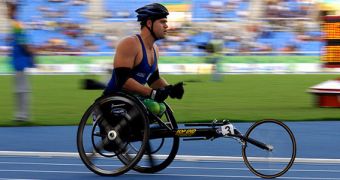A team of scientists at the University of Louisville in Kentucky (ULK) recently conducted a study where four test participants previously diagnosed with complete paralysis underwent a procedure involving the use of electrical stimulation on their spinal cords. All four individuals were then able to move their knees, ankles, and toes intentionally, a capability that has never been achieved before.
Experts with the ULK research group say that these are among the first results ever obtained that may truly provide some hope for people who suffer from complete paralysis and are confined to a wheelchair for the rest of their lives. Details of how the spinal electrical stimulation procedure works were published in the April 9 issue of the scientific journal Brain.
Less than 3 years ago, the same research group demonstrated that applying stimulation directly to the spine could allow people who were paralyzed from the chest down to stand up on their own, sometimes for several minutes at a time. The new study is the continuation of that groundbreaking pilot trial.
One of the main concerns that were voiced in 2011 was whether or not those results could be replicated in more patients. The new research demonstrated the same capabilities in 4 different test participants and showed that additional tasks can also be mastered, including voluntary foot and leg movements.
The investigation was supported through a grant from the National Institute of Biomedical Imaging and Bioengineering (NIBIB) at the US National Institutes of Health (NIH). The team says that two of the test subjects had motor and sensory complete paralysis, which means that more direct neural connections existed between their brains and their legs, IEEE Spectrum reports.
“When we first learned that a patient had regained voluntary control as a result of spinal stimulation, we were cautiously optimistic,” explains Roderic Pettigrew, who is the director of the NIBIB.
“Now that spinal stimulation has been successful in four out of four patients, there is evidence to suggest that a large cohort of individuals previously with little realistic hope of any meaningful recovery from spinal cord injury may benefit from this intervention,” the official explains.
All four patients received electrical stimulation impulses via an array of 16 electrodes that ULK experts had implanted in the epidural space, right next to the outermost layer of the spine. Nearby, pacemaker-like devices were also implanted and connected to the arrays via thin wires. The rigs then produced short pulses that stimulated the outermost protective layers around the spinal cord.
What is even more interesting is that scientists with the research team cannot figure out exactly why the stimulation works, particularly when considering that it is effective even when no neurons connect the brain to lower-body muscles. A series of new researches is needed to assess this connection, the team says.

 14 DAY TRIAL //
14 DAY TRIAL //